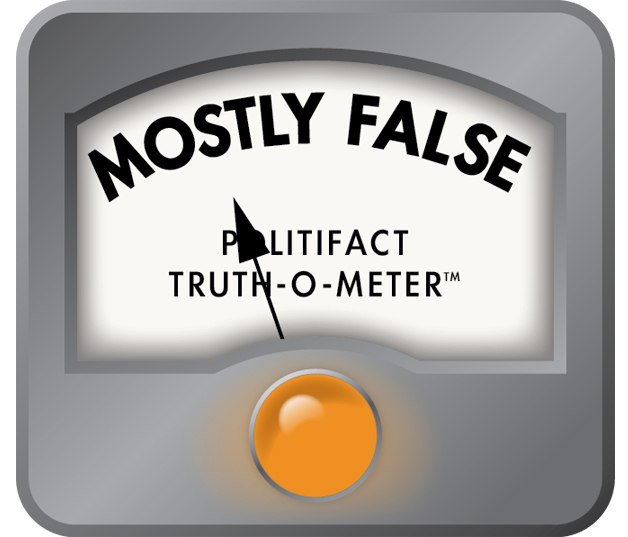Stand up for the facts!
Our only agenda is to publish the truth so you can be an informed participant in democracy.
We need your help.
I would like to contribute
Did crime in Midtown go up 30 percent in the last quarter?
As Mayor Rick Kriseman boasts about low crime in St. Petersburg, his opponent, former Mayor Rick Baker is firing back with statistics of his own.
During an interview with WFLA-Ch. 8, Baker criticized Kriseman’s efforts in Midtown, the area just south of downtown St. Petersburg. A large portion of undecided voters live in Midtown, making it a battleground in the St. Petersburg mayor’s race. The nonpartisan election will be held Aug. 29, 2017.
"Let’s get back to the Midtown area, which you brought up before. You’ve also criticized Kriseman for not doing enough for residents there. He says that crime is down by 6 percent and officers are more engaged in the community," WFLA-Ch. 8 anchor Paul Mueller said June 25. "So, with that being said, what else would you do if elected?"
"Well the Midtown crime is up by 30 percent the last quarter, so I don't know what statistics he’s looking at," Baker responded.
His claim about crime going up made us wonder — what statistic is he looking at? As it turns out, Baker’s claim relies on shaky data.
Police department stopped validating location of crimes by neighborhood at the end of 2015
PolitiFact Florida reached out to the St. Petersburg Police Department for a quarterly breakdown of crime in Midtown.
The department said they stopped validating the location of crimes by neighborhoods when the police department replaced its crime recording application in 2016. The old system was around 20 years old and failing.
While the police department does record the location of calls for service, it does not include the specific neighborhood location on the validated data sent to the Florida Department of Law Enforcement, because the FDLE does not record the data by specific address.
Still, the department was able to provide a breakdown of crime in Midtown from 2001 to 2015 when it used the old system.
The number of crimes in Midtown dropped significantly from 2009 to the end of 2015. But the police department was not able to provide crime data for 2016 and 2017 in Midtown, making it hard to assess the accuracy of Baker’s claim.
When we told Baker campaign spokesperson Brigitta Shouppe about this, she provided PolitiFact Florida with a breakdown of crime data throughout the city by the first quarters of every year. The breakdown included Midtown.
It showed that crime in Midtown went up 30 percent in the first quarter of 2017 (January to March) in comparison to the first quarter of 2016 (January to March).
The data includes homicides, forcible sex, robbery, aggravated assault, burglary, larceny and automobile theft. The 30 percent increase means the number of incidents increased from 544 to 706, according to Baker’s data.
The police department could not verify the 2016 and 2017 breakdown provided by Baker. It said the data presented was based on a "working document," and was not ready for release due to the unsubstantiated numbers.
Baker was vague about where the data came from, saying only that the police department provided it and that it came without disclaimers.
We checked in with community advocates to see if they had noticed recent crime spikes. They told us that crime in Midtown is an ongoing issue of concern, but they had noticed no recent changes.
Baker’s evidence relies on uncertain data
There are a few problems with Baker’s numbers. First off, experts agreed that if the police department can’t verify the numbers presented by Baker, the data should be treated with caution.
And, regardless of whether the data is accurate, experts said there are better practices to understand trends in crime.
"Generally speaking, most criminologists would agree that to understand what is driving crime, we need to examine long-term trends," said Lyndsay Boggess, an associate professor of criminology at the University of South Florida. "The social and economic conditions that lead to crime are complex and multi-faceted and slow to change."
Crime rates fluctuate so even if the increase is accurate in one three-month period, it’s not necessarily a cause for alarm.
For example, in the previous quarterly comparison provided by Baker from 2015 to 2016, the Midtown neighborhood saw a 20 percent decrease in crime. If you go back even further, after a decade or so, every year with a first quarter increase in crime was followed by a decrease during the same months in the following year.
"The fact that the fluctuations across the years is fairly significant makes me wonder about the accuracy of the data," said Bill Bales, a professor in the College of Criminology and Criminal Justice at Florida State University.
So, we can’t say for certain whether Baker’s claim is accurate.
The police department makes crime data accessible online that shows crimes counts for the city broken down by months, not just the first quarters of every month.
What about overall crime in the city?
During the New Channel 8 interview, the anchor mentioned that Kriseman said that crime had dropped 6 percent. The Kriseman campaign said that figure was in reference to the overall crime in St. Petersburg, not just Midtown.
Kriseman’s figure is accurate if you look at the number of crimes that have occurred from 2013 to 2016.
According to Uniform Crime Reporting statistics published by the FBI, there were 15,560 total crimes in 2013 (the last year of former Mayor Bill Foster’s term) and at the end of 2016 there were 14,531 total crimes.
That’s a little more than a 6 percent drop.
But like experts said, it’s better to look at rates, and the FBI breaks those down by violent crime (murder and nonnegligent manslaughter, forcible rape, robbery and aggravated assault) and property crime (burglary, larceny-theft, motor vehicle theft and arson.)
As you can see, for the most part, property crime and violent crime rates trends have been down since the 1990s in St. Petersburg.
Our ruling
Baker said that crime in Midtown is up 30 percent in the last quarter.
Baker says he got the statistics from the police, but he’s leaving out critical context. Most importantly, the St. Petersburg Police Department stopped validating data with neighborhood location at the end of 2015. The quarter-to-quarter comparison provided by Baker’s team relies on uncertain data and looks at a small time frame.
We rate this claim Mostly False.
Our Sources
Interviews, Brigitta Shouppe, campaign spokeswoman for Rick Baker, June 30-July 7
Interview, mayoral candidate Rick Baker, July 8, 2017
Email exchange, Benjamin Kirby, mayor's communications director, July 7
Email exchange, Jacob Smith, mayor’s campaign manager, July 7
Interview, St. Petersburg Police Chief Tony Holloway, July 5, 2017
Interview, St. Petersburg Police Department spokesperson Yolanda Fernandez, July 5, 2017
Interviews, St. Petersburg Police Department Records and Evidentiary Services Division Manager Colleen Dunphy, June 29-July 5
Interview, James Myles of St. Petersburg is the executive director of Bethel Community Foundation Inc., July 10
Email interview, Bill Bales, professor in the College of Criminology and Criminal Justice at Florida State University, July 6
Email interview, John Cochran, professor of Criminology at the University of South Florida, July 8, 2017
Email interview, Lyndsay N. Boggess, Associate Professor, Department of Criminology at the University of South Florida, July 6, 2017
Tampa Bay Times, "St. Pete Poll adjusts numbers in mayor's race," June 30, 2017
WFLA, News Channel 8, "Former Mayor Rick Baker talks about running for his old office," June 25, 2017
FBI Uniform Crime Reporting data, "Crime reported by St. Petersburg Police Dept, Florida"
1990-2016
St. Petersburg Police Department , "Department Reports / Crime Statistics: UCR Annual Report."
Browse the Truth-O-Meter
More by Allison Graves
Did crime in Midtown go up 30 percent in the last quarter?
Support independent fact-checking.
Become a member!
In a world of wild talk and fake news, help us stand up for the facts.






 PolitiFact Rating:
PolitiFact Rating: 















































